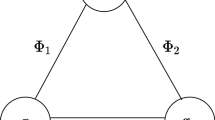Summary
ASU(2) gauge-invariant dynamics based on only one left-handed isodoublet fermion field, an isovector gauge field and a non-Hermitian isotriplet scalar Higgs field is shown to effectively produce, as a consequence of condensation of circularly polarized Higgs modes, all the features of the orthodox Glashow-Weinberg-Salam model—a right-handed isosinglet fermion field in addition to the left-handed isodoublet, an extended local symmetryU(1, loc)⊗SU(2, loc) including hypercharge with the extended set of gauge fields and the apparent isodoublet structure of the breakdown of theU(1)⊗SU(2) symmetry—with the additional stipulations: 1) the Weinberg angle is fixed (in lowest order) at\(\sin ^2 \theta _W = \raise.5ex\hbox{$\scriptstyle 1$}\kern-.1em/ \kern-.15em\lower.25ex\hbox{$\scriptstyle 4$} \), 2) the neutrino has to be massless on group-theoretical grounds, 3) there exists an additional massless neutrino decoupled from the electroweak gauge sector but extremely weakly coupled to the usual fermions via an additional, presumably very massive, Higgs doublet. The dynamics proposed is thought of as an attempt towards a unification with a minimum number of basic fields.
Riassunto
Si mostra che una dinamicaSU(2) invariante di gauge basata su un unico campo fermionico sinistrorso a isodoppietti, un campo di gauge isovettoriale e un campo scalare di Higgs non hermitiano a isotripletti produce effettivamente, come conseguenza della condensazione dei modi di Higgs polarizzati circolarmente, tutte le caratteristiche del modello ortodosso di Glashow-Weinberg-Salam—un campo fermionico destrorso a isosingoletti oltre all'isodoppietto sinistrorso, una simmetria locale estesaU(1, loc)⊗SU(2, loc) che include l'ipercarica con l'insieme esteso di campi di gauge e l'apparente struttura a isodoppietti della caduta della simmetriaU(1)⊗SU(2)— con queste clausole supplementari: 1) l'angolo di Weinberg è fissato (nell'ordine inferiore) a\(\sin ^2 \theta _W = \raise.5ex\hbox{$\scriptstyle 1$}\kern-.1em/ \kern-.15em\lower.25ex\hbox{$\scriptstyle 4$} \), 2) il neutrino deve essere privo di massa sulla base della teoria dei gruppi, 3) esiste un neutrino supplementare privo di massa disaccoppiato dal settore di gauge elettrodebole ma accoppiato in modo estremamente debole ai fermioni usuali mediante un doppietto supplementare di Higgs, probabilmente con una grande massa. Si pensa che la dinamica proposta sia un tentativo di unificazione con un numero minimo di campi di base.
Резюме
Показывается, чтоSU(2) калибровочно инвариантная динамика, основанная только на одном левостороннем изодублетном фермионном поле, изовекторном калибровочном поле и неэрмитовом изотриплетном скалярном поле Хиггса, эффективно воспроизводит, вследствие конденсации циркулярно поляризованных мод Хиггса, все особенности ортодоксальной модели Глашоу-Вейнберга-Салама—правосторонний изосинглетный фермион в дополнение к левостороннему изодублету, протяженную локальную симметриюU (1, loc)⊗SU(2,loc), включая гиперзаряд с протяженной системой калибровочных полей, и явную изодублетную структуру нарушения симметрииU(1)⊗SU(2)—с дополнительными условиями: 1) угол Вейнберга является фиксированным (в низшем порядке)\(\sin ^2 \theta _W = \raise.5ex\hbox{$\scriptstyle 1$}\kern-.1em/ \kern-.15em\lower.25ex\hbox{$\scriptstyle 4$} \) 2) нейтрино должно быть с нулевой массой, исходя из соображений теории групп; 3) существует дополнительное безмассовое нейтрино, не связанное из электро-слабого калибровочного сектора, но чрезвычайно слабо связанное с обычными фермионами через дополнительный, вероятно очень тяжелый, дублет Хиггса. Предложенная динамика представляет попытку унификации минимального числа базисных полей.
Similar content being viewed by others
References
S. L. Glashow:Nucl. Phys.,22, 579 (1961);S. Weinberg:Phys. Rev. Lett.,19, 1264 (1967);A. Salam:Proceedings of the VIII Nobel Symposium (1968).
See,e.g.,D. V. Nanopoulos: preprint TH 2896-CERN (1980), and references quoted therein.
D. Bardeen, L. N. Cooper andJ. R. Schrieffer:Phys. Rev.,108, 1175 (1957).
Y. Nambu andG. Jona-Lasinio:Phys. Rev.,122, 345 (1961);124, 246 (1961).
L. Susskind:Phys. Rev. D,20, 2619 (1979);P. Sikivie: preprint TH-2951-CERN (1980).
H. P. Dürr andH. Saller:Phys. Lett. B,84, 336 (1979);Nuovo Cimento A,53, 469 (1979).
Seee.g.,J. E. Kim, P. Langacker, M. Levine andH. H. Williams: University of Pennsylvania preprint UPR-158 (1980).
H. P. Dürr, W. Heisenberg, H. Mitter, S. Schlieder andK. Yamazaki:Z. Naturforsch. Teil A,14, 441 (1959);H. P. Dürr andW. Heisenberg:Z. Naturforsch. Teil A,16, 726 (1961);H. P. Dürr:Properties of Matter under Unusual Conditions, edited byH. Mark andS. Fernbach (New York, N. Y., 1969);H. P. Dürr:Group-Theoretical Methods in Physics, Springer Lecture Notes, Vol.79, (Berlin, 1977), p. 259.
H. P. Dürr andH. Saller:Nuovo Cimento A,39, 31 (1977);41, 677 (1977);48, 505, 561 (1978);Phys. Rev. D,22, 1176 (1980).
V. L. Ginzburg andL. D. Landau:Ž. Ėksp. Teor. Fiz.,20, 1064 (1950); see alsoW. Jones andN. March:Theoretical Solid State Physics, Vol. II (London, 1969).
M. Georgi andS. L. Glashow:Phys. Rev. Lett.,28, 1494 (1972).
H. Umezawa:Nuovo Cimento,38, 1415 (1965);40, 450 (1965);S. Coleman Erice Lectures (1973).
H. P. Dürr andH. Saller:Nuovo Cimento A,60, 79 (1980).
S. Mandelstam:Ann. Phys. (N. Y.),19, 1, 25 (1962);I. Białynicki-Birula:Bull. Acta Pol. Sci.,10, 135 (1963).
H. P. Dürr andH. Saller:Phys. Rev. D,22, 1176 (1980);H. Saller: preprint MPI-PAE/PTh 58/80 (December 1980);H. P. Dürr: preprints MPI-PAE/PTh 39/80 (September 1980) and 4/81 (March 1981).
H. B. Nielsen andP. Olesen:Nucl. Phys. B,61, 45 (1973).
T. Kugo andI. Ojima:Prog. Theor. Phys.,60, 1869 (1978).
Author information
Authors and Affiliations
Additional information
Traduzione a cura della Redazione.
Переведено редакцией.
Rights and permissions
About this article
Cite this article
Dürr, H.P., Saller, H. Towards a radical unification— Effective generalization of hypercharge from isospin. Nuov Cim A 65, 147–194 (1981). https://doi.org/10.1007/BF02902134
Received:
Published:
Issue Date:
DOI: https://doi.org/10.1007/BF02902134



